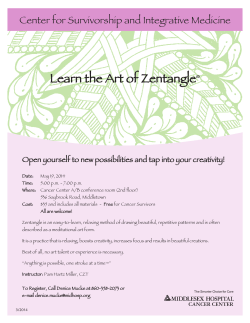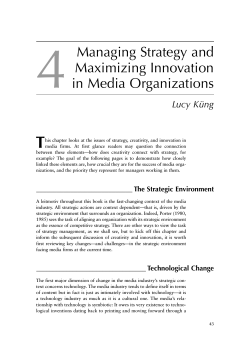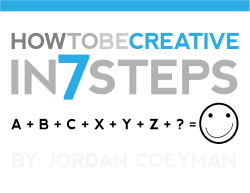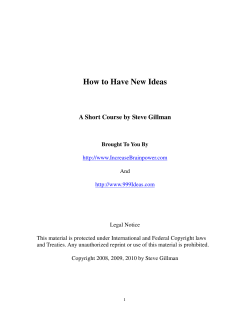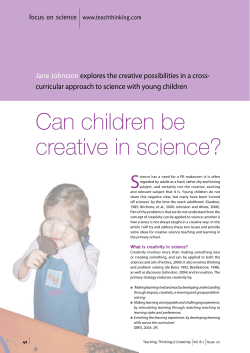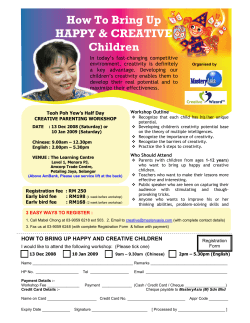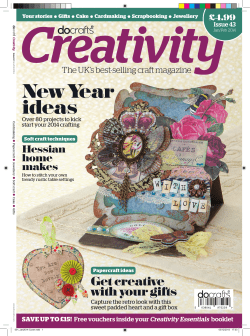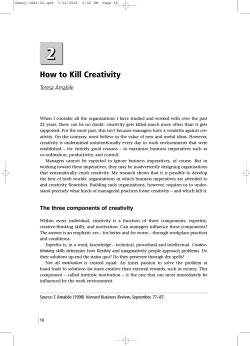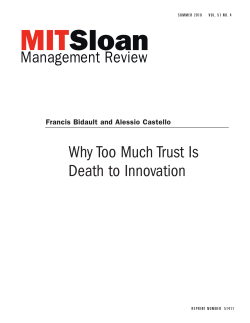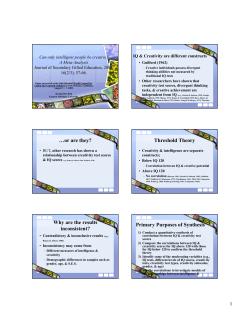
Document 244968
http://www.ascd.org/publications/educational_leadership/sept09/vol67/num01/Why_Creativity_Now%C2%A... PUBLICATIONS Home Current Issue Archives Search Buy Contact September 2009 | Volume 67 | Number 1 Teaching for the 21st Century Pages 22-26 Why Creativity Now? A Conversation with Sir Ken Robinson Amy M. Azzam Creativity: It's been maligned, neglected, and misunderstood. But it's finally coming into its own. Here, creativity expert Sir Ken Robinson makes the case for creativity as the crucial 21st century skill we'll need to solve today's pressing problems. Sir Ken led the British government's 1998 advisory September 2009 committee on creative and cultural education and was knighted in 2003 for his achievements. His most recent book, The Element (Viking Adult, 2009), looks at human creativity and education. He is also the author of Out of Our Minds: Learning to Be Creative (Capstone Publishing Limited, 2001). Both creativity and critical thinking have been flagged as essential 21st century skills, yet some people think of them as being as separate as oil and water. What's your take? It's interesting that people see creativity and critical thinking as being opposed. It's partly because people associate creativity with being totally free and unstructured. But what we really have to get hold of is the idea that you can't be creative if you don't do something. You can be creative in math, science, music, dance, cuisine, teaching, running a family, or engineering. Because creativity is a process of having original ideas that have value. A big part of being creative is looking for new ways of doing things within whatever activity you're involved in. If you're a creative chef, for example, then your originality is going to be judged in terms of cuisine. There's no point applying the criteria of modern jazz to somebody who's trying to create a new soufflé. A creative process may begin with a flash of a new idea or with a hunch. It may just start as noodling around with a problem, getting some fresh ideas along the way. It's a process, not a single event, and genuine creative processes involve critical thinking as well as imaginative insights and fresh ideas. But creativity isn't just about coming up with new ideas; some ideas might be completely crazy and impractical. So an essential bit of every creative process is evaluation. If you're working on a mathematical problem, you're constantly evaluating it, thinking, "Does that feel right?" If you're composing a piece on the piano, part of you is listening to what you're doing and thinking, "Does that work? Is that going in a good direction?" What's the biggest misconception people have about creativity? One is that it's about special people—that only a few people are really creative. Everybody has tremendous creative capacities. A policy for creativity in education needs to be about everybody, not just a few. The second misconception is that creativity is about special activities. People associate creativity with the arts only. I'm a great advocate of the arts, but creativity is really a function of everything we do. So education for creativity is about the whole curriculum, not just part of it. The third misconception is that creativity is just about letting yourself go, kind of running around the room and going a bit crazy. Really, creativity is a disciplined process that requires skill, knowledge, and control. Obviously, it also requires imagination and inspiration. But it's not simply a question of venting: It's a 1 of 4 10/28/09 11:28 AM http://www.ascd.org/publications/educational_leadership/sept09/vol67/num01/Why_Creativity_Now%C2%A... disciplined path of daily education. If you look at some of the people we most respect for their creative achievements, it's because of the extraordinary insights, breakthroughs, and discipline they have brought to their work. Why do you think creativity is especially important right now? The challenges we currently face are without precedent. More people live on this planet now than at any other time in history. The world's population has doubled in the past 30 years. We're facing an increasing strain on the world's natural resources. Technology is advancing at a headlong rate of speed. It's transforming how people work, think, and connect. It's transforming our cultural values. If you look at the resulting strains on our political and financial institutions, on health care, on education, there really isn't a time in history where you could look back and say, "Well, of course, this is the same thing all over again." It isn't. This is really new, and we're going to need every ounce of ingenuity, imagination, and creativity to confront these problems. Also, we're living in times of massive unpredictability. The kids who are starting school this September will be retiring—if they ever do—around 2070. Nobody has a clue what the world's going to look like in five years, or even next year actually, and yet it's the job of education to help kids make sense of the world they're going to live in. You know, for my generation—I was born in 1950—we were told that if you worked hard, went to college, and got a regular academic degree, you'd be set for life. Well, nobody thinks that's true anymore, and yet we keep running our school systems as though it were. So many people have degrees now that an individual degree isn't worth a fraction of what it used to be worth. So being creative is essential to us; it's essential for our economy. I work a lot with Fortune 500 companies, and they're always saying, "We need people who can be innovative, who can think differently." If you look at the mortality rate among companies, it's massive. America is now facing the biggest challenge it's ever faced—to maintain it's position in the world economies. All these things demand high levels of innovation, creativity, and ingenuity. At the moment, instead of promoting creativity, I think we're systematically educating it out of our kids. Is creativity at odds with a culture of standardized testing? We have a major problem with our education systems, not just in America, but in many of the old, industrialized countries. If you have a system as in the United States where there's a 30 percent high school dropout rate—in the African American/Latino communities it's over 50 percent, and in some of the Native American communities it's nearly 80 percent—you can't just blame the kids for it. With that amount of waste, there's something wrong with the system— with impersonal forms of education, with people sitting in rows and not discovering the things that impassion them or invigorate them or turn them on. That's increasingly the case with this culture of standardized testing. It's totally counterproductive. Looking back at our own education, we came alive in certain sorts of lessons with certain teachers when we were given an opportunity to do things that invigorated us. And when you find things you're good at, you tend to get better at everything because your confidence is up and your attitude is different. Too often now we are systematically alienating people from their own talents and, therefore, from the whole process of education. This isn't, to me, a whimsical argument, like, "Wouldn't it be nice if we all did something we liked." It's a fundamental human truth that people perform better when they're in touch with things that inspire them. For some people, it's gymnastics; for some people, it's playing the blues; and for some people, it's doing calculus. We know this because human culture is so diverse and rich—and our education system is becoming increasingly dreary and monotonous. It's no surprise to me that so many kids are pulling out of it. Even the ones who stay are often detached. Only a few people benefit from this process. But it's far too few to justify the waste. People often associate creativity with the individual. But is there a social dimension to creativity that's particularly relevant in the 21st century? Absolutely. Most original thinking comes through collaboration and through the stimulation of other people's ideas. Nobody lives in a vacuum. Even people who live on their own—like the solitary poets or solo inventors in their garages—draw from the cultures they're a part of, from the influence of other 2 of 4 10/28/09 11:28 AM http://www.ascd.org/publications/educational_leadership/sept09/vol67/num01/Why_Creativity_Now%C2%A... people's minds and achievements. In practical terms, most creative processes benefit enormously from collaboration. The great scientific breakthroughs have almost always come through some form of fierce collaboration among people with common interests but with very different ways of thinking. This is one of the great skills we have to promote and teach—collaborating and benefiting from diversity rather than promoting homogeneity. We have a big problem at the moment—education is becoming so dominated by this culture of standardized testing, by a particular view of intelligence and a narrow curriculum and education system, that we're flattening and stifling some of the basic skills and processes that creative achievement depends on. Look at Thomas Edison. He was one of the most prolific inventors in American history. He had over 1,100 patents in the U.S. Patent Office. But actually, Edison's great talent was mobilizing other people. He had teams of cross-disciplinary groups working with him. They gave themselves clear objectives and tight deadlines and pulled out every stop to work collaboratively. So there's no doubt in my mind that collaboration, diversity, the exchange of ideas, and building on other people's achievements are at the heart of the creative process. An education that focuses only on the individual in isolation is bound to frustrate some of those possibilities. Can you teach creativity? Yes. But people think they can't teach it because they don't understand it themselves. They say, "Well, I'm not very creative, so I can't do it." But there are actually two ways of thinking about teaching creativity. First of all, we can teach generic skills of creative thinking, just in the way we can teach people to read, write, and do math. Some basic skills can free up the way people approach problems—skills of divergent thinking, for example, which encourage creativity through the use of analogies, metaphors, and visual thinking. I worked a while ago with an executive group of a Native American community. They wanted me to talk to them about how they could promote innovation across their tribe. We sat around a boardroom table for the first hour, and I guess they were expecting me to get some flip charts out and show them some techniques. We did a little of that, but what I actually got them to do was to get into groups and draw pictures of some of the challenges they're facing as a community. Well, the minute you get people to think visually—to draw pictures or move rather than sit and write bullet points—something different happens in the room. Breaking them up so they aren't sitting at the same desk and getting them to work with people they wouldn't normally sit with creates a different type of dynamic. So you can teach people particular skills to free up their own thinking, of valuing diversity of opinion in a room. But in addition to teaching those skills, there's also personal creativity. People often achieve their own best work at a personal level when they connect with a particular medium or set of materials or processes that excites them. My new book, The Element, is about finding your passion. I talked to many people—gymnasts, musicians, scientists, an amazing woman who was a pool player. Whether it was music or jazz or the triple jump, each of them found something that they resonated with, that they had a personal aptitude for. If you combine a personal aptitude with a passion for that same thing, then you go into a different place creatively. You know, Eric Clapton was given his first guitar about the same time I was. Well, it worked out for Eric in a way it didn't quite work out for me. He got the hang of it, but also combined it with tremendous passion. If creativity and innovation are so important, should we assess them? You can't assess people—in general—for being creative because you have to be doing something to be creative. If you're working in math class and the teaching is encouraging you to look for new approaches, to try new ways of thinking, then of course you can begin to judge the level of creativity and imaginativeness within the framework of mathematics as you would within the framework of music or dance or literature. I make a distinction between teaching creatively and teaching for creativity. Teaching creatively means that teachers use their own creative skills to make ideas and content more interesting. Some of the great teachers we know are the most creative teachers because they find a way of connecting what they're 3 of 4 10/28/09 11:28 AM http://www.ascd.org/publications/educational_leadership/sept09/vol67/num01/Why_Creativity_Now%C2%A... teaching to student interests. But you can also talk about teaching for creativity, where the pedagogy is designed to encourage other people to think creatively. You encourage kids to experiment, to innovate, not giving them all the answers but giving them the tools they need to find out what the answers might be or to explore new avenues. Within particular domains, it's perfectly appropriate to say, "We're interested in new and original ways you can approach these issues." Whether there would be an individual grade for creativity, that's a larger question. Certainly giving people credit for originality, encouraging it, and giving kids some way of reflecting on whether these new ideas are more effective than existing ideas is a powerful part of pedagogy. But you can't reduce everything to a number in the end, and I don't think we should. That's part of the problem. The regime of standardized testing has led us all to believe that if you can't count it, it doesn't count. Actually, in every creative approach some of the things we're looking for are hard, if not impossible, to quantify. But that doesn't mean they don't matter. When I hear people say, "Well, of course, you can't assess creativity," I think, "You can—just stop and think about it a bit." Sir Ken Robinson is an internationally recognized leader in the development of creativity, innovation, and human resources; www.sirkenrobinson.com. Amy M. Azzam is Senior Associate Editor, Educational Leadership, aazzam@ascd.org. Copyright © 2009 by ASCD 4 of 4 10/28/09 11:28 AM
© Copyright 2025


